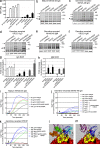Engineering HIV envelope protein to activate germline B cell receptors of broadly neutralizing anti-CD4 binding site antibodies
- PMID: 23530120
- PMCID: PMC3620356
- DOI: 10.1084/jem.20122824
Engineering HIV envelope protein to activate germline B cell receptors of broadly neutralizing anti-CD4 binding site antibodies
Abstract
Broadly neutralizing antibodies (bnAbs) against HIV are believed to be a critical component of the protective responses elicited by an effective HIV vaccine. Neutralizing antibodies against the evolutionarily conserved CD4-binding site (CD4-BS) on the HIV envelope glycoprotein (Env) are capable of inhibiting infection of diverse HIV strains, and have been isolated from HIV-infected individuals. Despite the presence of anti-CD4-BS broadly neutralizing antibody (bnAb) epitopes on recombinant Env, Env immunization has so far failed to elicit such antibodies. Here, we show that Env immunogens fail to engage the germline-reverted forms of known bnAbs that target the CD4-BS. However, we found that the elimination of a conserved glycosylation site located in Loop D and two glycosylation sites located in variable region 5 of Env allows Env-binding to, and activation of, B cells expressing the germline-reverted BCRs of two potent broadly neutralizing antibodies, VRC01 and NIH45-46. Our results offer a possible explanation as to why Env immunogens have been ineffective in stimulating the production of such bNAbs. Importantly, they provide key information as to how such immunogens can be engineered to initiate the process of antibody-affinity maturation against one of the most conserved Env regions.
Figures





References
-
- Binley J.M., Lybarger E.A., Crooks E.T., Seaman M.S., Gray E., Davis K.L., Decker J.M., Wycuff D., Harris L., Hawkins N., et al. 2008. Profiling the specificity of neutralizing antibodies in a large panel of plasmas from patients chronically infected with human immunodeficiency virus type 1 subtypes B and C. J. Virol. 82:11651–11668 10.1128/JVI.01762-08 - DOI - PMC - PubMed
-
- Diskin R., Scheid J.F., Marcovecchio P.M., West A.P., Jr, Klein F., Gao H., Gnanapragasam P.N., Abadir A., Seaman M.S., Nussenzweig M.C., Bjorkman P.J. 2011. Increasing the potency and breadth of an HIV antibody by using structure-based rational design. Science. 334:1289–1293 10.1126/science.1213782 - DOI - PMC - PubMed
-
- Gray E.S., Madiga M.C., Hermanus T., Moore P.L., Wibmer C.K., Tumba N.L., Werner L., Mlisana K., Sibeko S., Williamson C., et al. ; CAPRISA002 Study Team 2011a. The neutralization breadth of HIV-1 develops incrementally over four years and is associated with CD4+ T cell decline and high viral load during acute infection. J. Virol. 85:4828–4840 10.1128/JVI.00198-11 - DOI - PMC - PubMed
-
- Gray G.E., Allen M., Moodie Z., Churchyard G., Bekker L.G., Nchabeleng M., Mlisana K., Metch B., de Bruyn G., Latka M.H., et al. ; HVTN 503/Phambili study team 2011b. Safety and efficacy of the HVTN 503/Phambili study of a clade-B-based HIV-1 vaccine in South Africa: a double-blind, randomised, placebo-controlled test-of-concept phase 2b study. Lancet Infect. Dis. 11:507–515 10.1016/S1473-3099(11)70098-6 - DOI - PMC - PubMed
-
- Hoot S., McGuire A.T., Cohen K.W., Strong R.K., Hangartner L., Klein F., Diskin R., Scheid J.F., Sather D.N., Burton D.R., Stamatatos L. 2013. Recombinant HIV envelope proteins fail to engage germline versions of anti-CD4bs bNAbs. PLoS Pathog. 9:e1003106 10.1371/journal.ppat.1003106 - DOI - PMC - PubMed
Publication types
MeSH terms
Substances
Grants and funding
LinkOut - more resources
Full Text Sources
Other Literature Sources
Molecular Biology Databases
Research Materials

